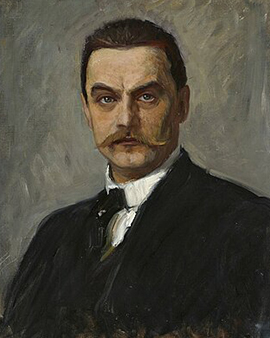The history of art has produced many outstanding personalities who have used their creativity to enrich the world. One such person is Albert Gustaf Aristides Edelfelt, a renowned Finnish painter who saw the light of day on July 21, 1854. Through his impressive body of work, Edelfelt helped bring Finnish culture to an international audience by creating his naturalistic and realistic artworks that capture the essence of the human experience. Edelfelt's artistic journey began at the age of 15, when he took his first steps in the art world at the Finnish Art Society's drawing school. A government scholarship enabled him to continue his artistic education at the Royal Academy of Fine Arts in Antwerp, Belgium. Under the tutelage of the Belgian historical painter Nicaise de Keyser, he devoted himself to historical painting. His portrait of Alexander the Great on his deathbed was highly praised during this period and helped him achieve his first significant success.
In addition to his academic development, Edelfelt also built personal connections that shaped his life and career. In particular, his friendship with Belgian artist Emile Claus had a strong influence on his artistic journey. After studying in Antwerp, Edelfelt moved to Paris, the city of lights and a center of art. There he studied at the prestigious Ecole des Beaux-Arts and deepened his knowledge and skills in history painting. During this phase of his creative work, he created the painting "Duke Charles IX of Sweden Insults the Corpse of his Enemy Klaus Fleming", which was widely admired in Finland, although it was less known in Paris. During his time in Paris, Edelfelt began to break away from history painting and explore new artistic forms. He became particularly interested in plein air painting, which he learned about through his friend, the painter Jules Bastien Lepage.
As his career progressed, Edelfelt turned to Impressionism. Despite his turn to this new style, however, he remained true to his realistic roots. With an extraordinary ability to capture everyday scenes in vibrant color and fine detail, he always paid tribute to the complexity of the color palette, which he mastered. Edelfelt had the rare gift of recognizing the beauty in life's simplest moments and capturing them on canvas. His works continue to inspire art lovers around the world. Finnish painter Albert Gustaf Aristides Edelfelt is a true gem of art history whose influence and contribution to the art scene are undeniable. Despite his death in 1905, his legacy lives on in his artworks, which are now displayed in museums and galleries around the world. Edelfelt's artwork is not only captured on canvas, but is also offered in the form of high-quality art prints. Each art print is a loving tribute to Edelfelt's artistic genius, reflected in every brushstroke and nuance of color.
×





.jpg)
.jpg)
.jpg)
.jpg)
.jpg)
.jpg)
.jpg)
.jpg)
.jpg)
.jpg)
.jpg)
.jpg)
.jpg)
.jpg)
.jpg)
.jpg)
.jpg)
.jpg)
 in his Laboratory 1885 - (MeisterDrucke-179913).jpg)
 in his Laboratory 1885 - (MeisterDrucke-179913).jpg)
.jpg)
.jpg)
.jpg)
.jpg)
_-_(MeisterDrucke-389517).jpg)
_-_(MeisterDrucke-389517).jpg)
.jpg)
.jpg)
.jpg)
.jpg)
.jpg)
.jpg)
.jpg)
.jpg)
.jpg)
.jpg)
_French_chemist_and_biologist_From_the_pain_-_(MeisterDrucke-1024037).jpg)
_French_chemist_and_biologist_From_the_pain_-_(MeisterDrucke-1024037).jpg)
.jpg)
.jpg)
.jpg)
.jpg)
.jpg)
.jpg)
.jpg)
.jpg)
.jpg)
.jpg)
.jpg)
.jpg)
.jpg)
.jpg)
.jpg)
.jpg)
.jpg)
.jpg)
_-_(MeisterDrucke-1660647).jpg)
_-_(MeisterDrucke-1660647).jpg)
.jpg)
.jpg)
.jpg)
.jpg)
.jpg)
.jpg)
.jpg)
.jpg)
.jpg)
.jpg)
.jpg)
.jpg)
.jpg)
.jpg)
.jpg)
.jpg)
.jpg)
.jpg)
 - (MeisterDrucke-296157).jpg)
 - (MeisterDrucke-296157).jpg)
.jpg)
.jpg)
.jpg)
.jpg)
.jpg)
.jpg)
.jpg)
.jpg)
.jpg)
.jpg)
.jpg)
.jpg)
.jpg)
.jpg)
.jpg)
.jpg)
_-_(MeisterDrucke-1053204).jpg)
_-_(MeisterDrucke-1053204).jpg)
.jpg)
.jpg)
_widow_of_French_physician_Louis_Pasteur_(_-_(MeisterDrucke-961273).jpg)
_widow_of_French_physician_Louis_Pasteur_(_-_(MeisterDrucke-961273).jpg)
.jpg)
.jpg)
.jpg)
.jpg)
.jpg)
.jpg)
_Topelius_(oil_on_cardboard)_-_(MeisterDrucke-991591).jpg)
_Topelius_(oil_on_cardboard)_-_(MeisterDrucke-991591).jpg)
.jpg)
.jpg)
 c1893 - (MeisterDrucke-237752).jpg)
 c1893 - (MeisterDrucke-237752).jpg)
.jpg)
.jpg)
.jpg)
.jpg)
.jpg)
.jpg)
.jpg)
.jpg)
.jpg)
.jpg)
.jpg)
.jpg)
.jpg)
.jpg)
.jpg)
.jpg)
.jpg)
.jpg)
.jpg)
.jpg)
.jpg)
.jpg)
.jpg)
.jpg)
.jpg)
.jpg)
.jpg)
.jpg)
.jpg)
.jpg)




